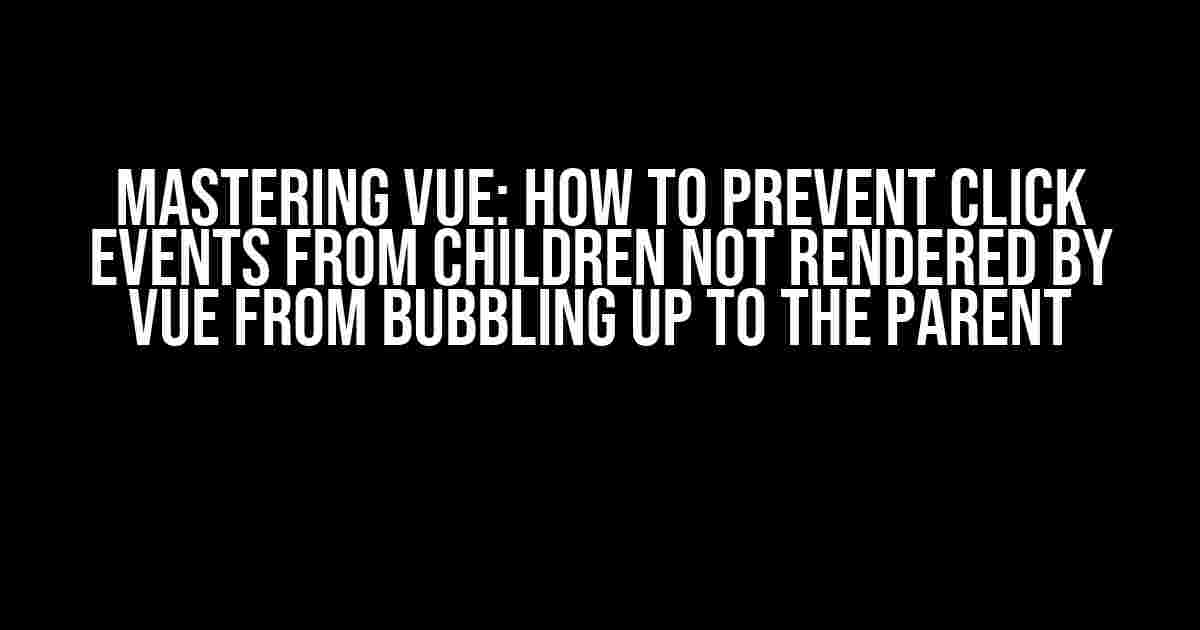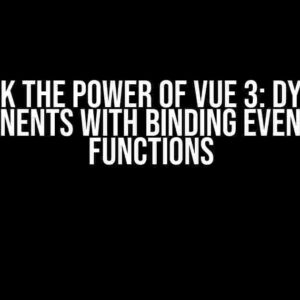Are you tired of dealing with pesky click events that insist on bubbling up to their parents, even when they’re not directly related to your Vue components? Well, buckle up, friend, because today we’re going to explore the nuances of event handling in Vue and provide you with a comprehensive guide on how to prevent those click events from causing chaos in your application.
Understanding Event Bubbling in Vue
Before we dive into the solution, let’s take a step back and understand how event bubbling works in Vue. When an event is triggered on a DOM element, it starts propagating upwards through the DOM tree, allowing parents to capture and respond to the event. This is known as event bubbling.
In Vue, when you render a component, it becomes a part of the DOM tree. If a child component is not rendered by Vue (e.g., a third-party library or a dynamically generated element), the click event can still bubble up to the parent Vue component, causing unintended consequences.
The Problem: Unwanted Click Events
Imagine you have a Vue component that renders a third-party library’s button:
<template>
<div>
<ThirdPartyButton></ThirdPartyButton>
</div>
</template>
<script>
export default {
mounted() {
this.$el.addEventListener('click', () => {
console.log('Parent component clicked!');
});
}
}
</script>
When you click the third-party button, the click event will bubble up to the parent Vue component and trigger the `console.log` statement. This might not be the desired behavior, especially if you’re trying to prevent the parent component from responding to the click event.
Methods to Prevent Click Events from Bubbling Up
Fear not, dear developer! We have several methods to prevent those pesky click events from bubbling up to the parent component:
Method 1: Use the `.stopPropagation()` Method
One way to prevent event bubbling is by using the `.stopPropagation()` method on the event object. This method stops the event from propagating up the DOM tree.
Here’s an example:
<template>
<div>
<ThirdPartyButton @click.stop="handleClick"></ThirdPartyButton>
</div>
</template>
<script>
export default {
methods: {
handleClick(event) {
event.stopPropagation();
console.log('Button clicked!');
}
}
}
</script>
In this example, we use the `.stopPropagation()` method to prevent the click event from bubbling up to the parent component.
Method 2: Use the `@click.prevent` Shortcut
Vue provides a convenient shortcut to prevent the event from bubbling up: the `@click.prevent` syntax.
<template>
<div>
<ThirdPartyButton @click.prevent="handleClick"></ThirdPartyButton>
</div>
</template>
<script>
export default {
methods: {
handleClick() {
console.log('Button clicked!');
}
}
}
</script>
This method is similar to using `.stopPropagation()`, but it’s a more concise way to achieve the same result.
Method 3: Use a Capture Phase Event Handler
Another approach is to use a capture phase event handler to catch the event before it reaches the parent component.
<template>
<div>
<ThirdPartyButton @click.capture="handleClick"></ThirdPartyButton>
</div>
</template>
<script>
export default {
methods: {
handleClick(event) {
event.stopPropagation();
console.log('Button clicked!');
}
}
}
</script>
In this example, we use the `@click.capture` syntax to capture the event in the capture phase, preventing it from bubbling up to the parent component.
Method 4: Use a Separate Event Handler on the Child Element
If you have control over the third-party library’s button, you can add a separate event handler to the child element itself.
<template>
<div>
<ThirdPartyButton @click="handleButtonClick"></ThirdPartyButton>
</div>
</template>
<script>
export default {
methods: {
handleButtonClick(event) {
event.stopPropagation();
console.log('Button clicked!');
}
}
}
</script>
In this example, we add a separate event handler to the child element, which stops the event from bubbling up to the parent component.
Best Practices and Considerations
When working with event handling in Vue, it’s essential to keep the following best practices and considerations in mind:
- Use the `@click` shorthand wisely: While the `@click` shorthand is convenient, it can lead to unintended consequences if not used carefully. Make sure to use it only when necessary and with a clear understanding of the event propagation mechanism.
- Avoid using `stopPropagation()` unnecessarily: Stopping event propagation can have unforeseen consequences, such as preventing other event handlers from being executed. Use this method judiciously and only when necessary.
- Keep event handlers organized and maintainable: As your application grows, it’s essential to keep event handlers organized and maintainable. Use a consistent naming convention and separate event handlers into distinct functions or components.
- Test thoroughly and debug carefully: Event handling can be complex, especially when working with third-party libraries or dynamically generated elements. Make sure to test your application thoroughly and debug carefully to catch any unintended event behavior.
Conclusion
In conclusion, preventing click events from bubbling up to the parent component in Vue requires a deep understanding of event propagation and the various methods to stop or capture events. By following the best practices and considerations outlined in this article, you’ll be well-equipped to handle even the most complex event handling scenarios in your Vue applications.
Remember, with great power comes great responsibility. Use your newfound knowledge wisely, and may the event handling force be with you!
| Method | Description |
|---|---|
| `.stopPropagation()` | Stops the event from propagating up the DOM tree |
| `@click.prevent` | Prevents the event from bubbling up to the parent component |
| `@click.capture` | Captures the event in the capture phase, preventing it from bubbling up |
| Separate event handler on the child element | Adds a separate event handler to the child element, stopping the event from bubbling up |
We hope this article has been informative and helpful. If you have any questions or need further clarification, please don’t hesitate to ask. Happy coding!
Here are the 5 Questions and Answers about “How to prevent the click event from a children not rendered by vue to bubble up to the parent” in HTML format with a creative voice and tone:
Frequently Asked Question
Get the inside scoop on how to stop those pesky click events from causing chaos in your Vue app!
Why do click events from children elements not rendered by Vue bubble up to the parent?
By default, Vue uses event delegation to bind events to the root element of the component. This means that when an event is triggered on a child element, it will bubble up to the parent element. This behavior is known as event bubbling.
How can I prevent the click event from a child element not rendered by Vue from bubbling up to the parent?
One way to prevent the click event from bubbling up is to use the `stopPropagation()` method on the event object. You can do this by adding a `@click.stop` handler to the child element. This will prevent the event from propagating up the DOM tree.
What if I want to prevent the event from being captured by Vue’s event delegation mechanism?
In that case, you can use the `capture` modifier on the event handler. For example, `@click.capture.stop` will prevent the event from being captured by Vue’s event delegation mechanism and also prevent it from bubbling up to the parent element.
Can I use CSS to prevent the click event from bubbling up?
While CSS can’t directly prevent event bubbling, you can use the `pointer-events` property to prevent the child element from receiving clicks. Set `pointer-events: none` on the child element, and the click event will not be triggered.
What if I need to prevent the click event from bubbling up to multiple parent elements?
In that case, you can use a combination of the `stopPropagation()` method and event delegation. Add a `@click.stop` handler to each parent element, and also use event delegation to bind the event handler to the root element of the component.



